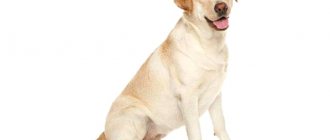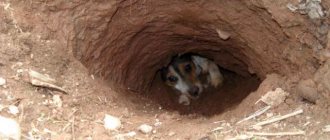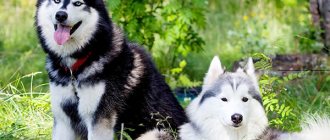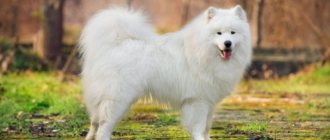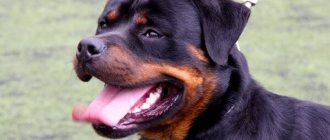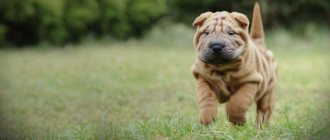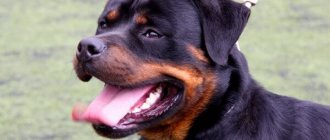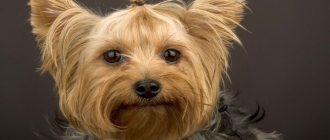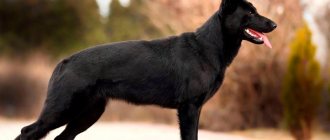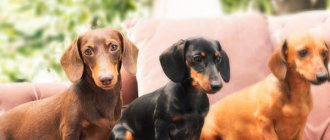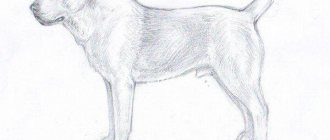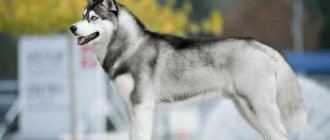Labradors are considered one of the most popular dog breeds these days.
Because of their friendly nature and easy-going nature, they have become family members and best friends for many.
These dogs fit perfectly into people's lives and filled it with emotions and new impressions.
After all, Labradors can add variety to even the most boring life.
What is the breed standard
A dog breed standard, including a Labrador, is a set of characteristics and physical attitudes for an animal that must be preserved for the purity of the breed and the health of the breed.
The standard was approved in 1987 for two varieties of breeds - American and English Labrador . The standard includes not only the exterior, but also the characteristics of the dog’s temperament.
In dog breeding, it is customary to focus on the English standard of the Labrador breed, because it was adopted somewhat earlier than the American one.
The American breed standard is not much different from the English, this mainly concerns the temperament of dogs - “Americans” are more active than “English”.
Maintenance, care
Growing Labrador puppies are a whirlwind, a hurricane and a typhoon rolled into one. They are extremely inquisitive, active and noisy, and are not yet fully accustomed to living in an apartment or house. They need to explore everything, try it out by heart, and a powerful tail wagging with lightning speed sweeps away everything in its path from tables, shelves and bedside tables. Therefore, in the first year and a half, until the puppy grows up and “settles down,” the apartment should be kept absolutely clean - household chemicals, books, shoes and other household items should be put in places where the young dog definitely cannot reach it.
In order for this pet to behave more quietly at home, it is advisable to take it for long walks during the day - having splashed out excess energy on the street, the growing Labrador will behave more quietly at home. But not for long. Given regular long walks after two years of age, such dogs will be less noisy and active at home. But before this age, you can forget about peace and quiet in the house.
Before buying a puppy, you should think about how to arrange the area in which it will live. It should be set up right away with the expectation that the dog will grow big and will not want to change its place. For the dog’s comfort, instead of the usual soft fabric, you should buy a special orthopedic mattress in a specialized pet store. Bowls or food stands should not slide. Before going to bed, it is better to walk your pet so that it does not disturb the sleep of others at night. Labradors are bathed as they become dirty.
The coat of these pets is short, so it requires less care, but there will still be a lot of falling hairs, especially if the dog is not walked for long. Many dog breeders have adapted to collecting dying hair with a vacuum cleaner pipe without an attachment, so first the puppy is accustomed to the noise of the vacuum cleaner, and then to similar collection of dying hairs. In this case, there will be less wool lying around the apartment.
There are many grooming tools for short-haired dogs, including:
- rubber scraper;
- furminator;
- wide stripping that perfectly combs out any undercoat.
Dogs up to one year old are usually combed only in order to accustom them to carrying out a similar procedure in the future, so you can use a regular massage brush.
Feeding
Dogs of this breed must spend most of the day in constant movement and are specially trained for long periods of work on rough terrain. Labradors also periodically have to swim in various bodies of water - natural or artificial - where the water is not always warm. Therefore, a layer of fat should accumulate under their skin, which will protect the dogs from hypothermia. In cold weather, these animals also spend energy to maintain heat.
So these tireless animals eat well, as if they were stocking up on food for several days. This animal is capable of eating and digesting any food, but you should remember that these dogs are prone to obesity, so you should never overfeed them!
The diet of these individuals should be:
- a well-balanced natural one recommended by a veterinarian;
- dry food, but only premium class.
To reward these pets for correctly executed commands, you can give a piece or two of chopped carrots, beets, or hard fruits. But encouragement should be in reasonable quantities, and not turn into a second lunch or dinner.
When this pet is fed dry food, one feeding can be done during a walk. When the dog has enough running, you can repeat the learned skills with it - this should be a calm training, without running or hurdles, since it will be followed by a full dinner. After such a long walk, combined with food, you can take the dog home - in this case, the pet will not disturb you at night.
Labradors do not have a stop signal for food, so he may constantly look at his owner and his family members with hungry eyes. However, this is not a reason to feed him from your plate, because the food that is put in his bowl is enough for him.
Upbringing
Dogs of this breed are easy to train and are much easier to train than representatives of other breeds. However, you should not put off training the purchased pet “for later”; it is important from the very beginning to accustom the puppy to the norms of behavior in the house and on walks.
Interesting! At three months, a Labrador puppy can perform tasks that are assigned to puppies of other breeds only at six months or later.
To train your pet, it is better to take it to classes with an instructor who conducts training according to a program specially designed for this breed.
This pet can be taught water rescue work, as this animal is a natural swimmer and loves to be in the water for a long time.
It should be remembered that in the first year or two you will need to pay maximum attention to the puppy in order to raise an obedient pet in the future. Although this pet is smart, the training process will require maximum patience from the owner.
Parenting mistakes
Owners should not delay raising these pets; if the training process is delayed even for a month or two, the puppy may develop bad habits that will take too long to correct.
This dog should not be allowed to beg for food from the common table - the Labrador must know that he will be fed only in a strictly designated place and at the appointed time.
You should not try to train this pet to be a watchman - this is not in his character, so the owner will only waste time trying to teach the Labrador to be watchdog qualities.
What does a dog look like according to the RKF?
- Torso . The Labrador's back line should be straight, the croup should be short and strong. There should be no hunchbacks. Labradors have a wide chest, barrel-shaped ribs, well-defined withers, and a medium-length tail, wide at the base and tapering towards the end. It’s hard to imagine Labradors without such an otter-like tail. It should be located horizontally to the lower back. In the active state, it can be slightly raised, but a crescent shape or bend behind the back is not allowed.
- Head and muzzle . Labradors have a large and massive skull, which stands out a little from the whole image. The cheeks are dry, not fleshy. The muzzle is slightly wide, not too long. Narrow or short is not allowed. The nose is large, with wide nostrils. Labradors' ears are in a hanging position and slightly behind the head. Should not be too long or heavy. The eyes have a friendly and intelligent appearance; only dark shades and medium-sized irises are allowed. The bite is scissor-shaped and the upper jaw completely covers the lower jaw. The neck is dry, long and without folds.
- Fore and hind limbs . The general appearance of the limbs is strong and muscular, located parallel to each other. The length of the forelimbs is equal to half the length of the animal at the withers. The pasterns are in the same plane as the forearm, the hock joints are clearly visible.
- Wool. Labradors have short hair, often short. It is hard to the touch, with a dense and dense undercoat underneath. The main feature is water resistance.
Expert opinion
Kozhevin Semyon Kirillovich
Expert dog handler.
“I think the main feature is the tail. This is what they look at, this is due to its specific shape. Another distinctive feature is the ears. They are located as if behind the head. It is also easy to check how purebred a Labrador is by looking at its undercoat. It is especially thick in this breed and also performs water-repellent functions. Well, basically Labradors look like strong and muscular dogs, their movements are smooth, cutting through the air.”
Shade and color
Three shades of color are allowed for Labrador Retrievers:
- Solid black;
- Pale yellow;
- Chocolate (brown or liver).
Fawn can range from light cream and golden to fox red. It is acceptable for them to have a small white spot on their chest.
Solid color means that the coat should not contain any other color or pigmentation. On the other hand, tan dogs may have a darker back than the rest of their body.
Black Labradors have a different undercoat color - it can be gray or reddish brown . This is due to the fact that any color can have its own shades.
For chocolate-colored Labradors, the tan that sometimes appears on them cannot be considered a solid color.
A dog's color may also change before and after shedding, but not significantly..
Conservatism won
The British were the first to recognize the Labrador Retriever breed. They also defined the first standard, which was refined several times. Today the description made in 1988 by the English Kennel Club is relevant. Six years after this, American dog breeders also set their standards. Later descriptions of breed qualities partially absorbed earlier ones.
In fact, evolution happens all the time with all standards. Indeed, in the process of development, a dog of any species acquires some new qualities or may lose those that become unnecessary. Accordingly, previously recognized standards are changing.
Continuing the comparison, you can notice that in all descriptions the dog has a wide skull, powerful loin and croup. However, Americans emphasize unwanted fleshiness on the scalp, considering it a drawback.
Until 1993, according to their standard, it was considered acceptable for a Labrador to have a level bite. This is currently unacceptable. The bite should only be scissor-shaped, that is, the upper incisors must tightly overlap the lower ones. It turns out that the conservative English view still prevailed.
Coat type
As already mentioned, this breed has short hair with a dense undercoat . It should be hard to the touch, dense and without bald spots. There should be no fringes or curls on it.
IMPORTANT!
The undercoat has water-repellent properties.
The undercoat is never the same color as the center coat . Its peculiarity is fat, which should be noticeable if you run your fingers over it.
Pet behavior
The Labrador Retriever's temperament has the following characteristics::
- This breed is distinguished by excessive intelligence and intelligence, which is what their look should indicate;
- They always try to be useful to a person, become attached, try to become a true friend for them;
- Get along equally well with adults and children;
- They have a high level of learning ability, because of this they are easy to train and amenable to education;
- They are friendly, kind and non-aggressive. Aggression is a disqualifying sign.
Can a dog change as it ages?
Like any other creature, your Labrador's behavior and appearance can change with age.
This is most evident in changes in character traits.
Aging Labradors now perceive separation differently; they become susceptible to separation from their owner and react to it especially acutely . When meeting, they can be violent, rejoicing at the return.
They also become less receptive to commands, and their activity decreases.
You can also notice changes in appearance - they look haggard, move slower than usual, the coat becomes more faded.
Character
It can be difficult for non-professionals to identify a breed based on its character. However, upon closer acquaintance, it becomes clear what features are characteristic of dogs. The following criteria should be considered:
- Determination. The Labrador is characterized by an immediate reaction. He immediately carries out any commands. The retriever is considered a more reserved dog that has self-control. Before executing a command, Golden spends time studying the situation.
- Activity. Fans of active walks should opt for Labrador. These dogs love to play, run and have fun with their owner. During entertainment, the pet is even capable of knocking a person down. Retrievers also love active walks. However, they have a more restrained character, which is why they misbehave much less.
- Sensitivity. When communicating with the owner, retrievers are considered more sensitive. They are able to quickly assess a person’s emotional state and, if necessary, provide support. Goldens are perfect for families with children with developmental delays. Labradors are considered less sensitive. However, due to their activity, they can quickly cheer up the owner.
Expert opinion
Karnaukh Ekaterina Vladimirovna
Graduated from the National University of Shipbuilding, majoring in Enterprise Economics
It is important to consider that both retrievers and Labradors are completely devoid of aggression. Therefore, it will not be possible to use them as guards.
How to distinguish a Labrador puppy from a mixed breed
It will not be difficult for an experienced owner to distinguish a Labrador from a mongrel, but beginners in this area may have questions:
- Any manifestation of aggression, even in a puppy, should alert you: Labradors do not have this quality.
- Labrador puppies have a slightly larger head than the rest of their body. They are somewhat robust, with medium-sized eyes, and their noses are not elongated or pointed.
- The ears should be completely hanging and not too long. Located behind the head.
- Another distinctive feature is the tail, similar to that of an otter.
- Dense coat, thick undercoat. It should be somewhat harsh to the touch, even for puppies.
- The color is solid, without spots or pigmentation. Only a white spot on the chest is allowed.
Pay attention to the puppy's behavior.
He should be active, but at the same time listen to your words . The look is conscious, interested and friendly.
How to choose a thoroughbred?
- Buy a puppy not “from hand”, but from nurseries and boarding schools that specialize in breeding them;
- Check the puppy's pedigree through a special database. There you will see his parents too;
- The puppy's appearance should be well-groomed and well-fed. There should be no discharge from the eyes, mouth or ears, the stomach should be free of rashes and not swollen;
- Look at the parents and ask the breeder in more detail about them: where they were exhibited, what titles they have, if the conversation goes well, then you can even ask for the relevant documents confirming his words;
- Look at the puppy's documents. They should contain information about the registration, his parents, the brand number that matches the one on the puppy;
- Check with the vet. a passport where all vaccinations given to him should be recorded;
- Compare the puppy with the standard indicators.
NOTE!
If you want to purchase a real purebred Labrador, you will have to spend a long time studying all the documents that the breeder provides and be extremely attentive to the details and his words.
Owner reviews
All owners unanimously mention the friendliness and calmness of Labradors, their tireless energy and extraordinary intelligence - they only need to repeat a command a couple of times, and they remember it forever. These dogs cannot stand loneliness, are sad, and love children very much.
Even training lessons for these dogs turn into a holiday, because their beloved owners are next to them.
